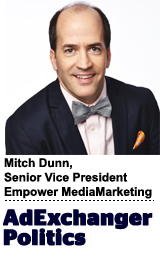 “AdExchanger Politics” is a new weekly column tracking developments in the 2016 political campaign cycle.
“AdExchanger Politics” is a new weekly column tracking developments in the 2016 political campaign cycle.
Today’s column is written by Mitch Dunn, senior vice president at Empower MediaMarketing.
Facebook as marketers know it is about to change, and we have super PACs to thank.
Due to the increasing prominence of super PACs, political fundraising is skyrocketing. As a result, political players are willing to spend a lot of premium dollars to deliver their messages via advertising. As people shift more of their time from traditional media to online, politicians are expected to do the same. Political campaigns, like marketers, want to be where people are, and that place is Facebook.
Facebook was already the most popular social platform for political advertising in 2014, according to The New York Times, and 2016 is expected to continue that trend. This is partially due to the targeting options available on the platform. As political organizations get more sophisticated about targeting certain demographics, Facebook offers a vast array of targeting that uses reliable demographic information.
For instance, if a campaign needed to target women from 18 to 24 years old in a specific ZIP code, they could use Facebook’s first-party data to target those exact people. Furthermore, Facebook has a unique feature that allows campaigns to upload an email list of their supporters, matching them to Facebook users and allowing campaigns to target their supporters quickly and efficiently, something that President Barack Obama’s 2012 re-election campaign did to great effect.
With Facebook political advertising spend continuing to grow, it could pose two unique problems to other marketers on Facebook.
Crowded News Feeds, Unpredictable CPMs
Due to Facebook’s strict limit on news feed ad frequency, if more campaigns continue to use Facebook, there could be a crowding-out effect for marketers. Since individual ads can only appear on Facebook twice a day, if there are more total ads, individual ad space in the news feed is likely to be limited.
There is also an issue of unpredictable CPMs. One notable trait of political campaigns is that they will typically focus on extremely small segments of the population, also known as microtargeting, and spend liberally to reach these specific segments. Thus, if a marketer is also targeting similar segments on Facebook, they may notice higher CPMs than normal for brief periods of time.
Reacting To The Potential Problems
Diligence, adaptability and diversification are key through next November.
Advertisers will have to be diligent about monitoring their Facebook campaigns to ensure that their CPMs stay stable. Also, if a desired target happens to be in high demand from political campaigns, it may be worth adapting by delaying a Facebook campaign until the election cycle is over or discontinuing Facebook audience segments in hotly contested swing states. Marketers could also use this as an opportunity to try something new on Facebook, such as a new tactic or testing of a niche target.
Finally, this may be a good time for marketers to diversify their social media mix. While Facebook remains the most popular social network, other networks, such as Snapchat and Instagram, offer great advertising options, and inventories on these sites may be less strained by political campaigns.
Follow Empower MediaMarketing (@EmpowerMM) and AdExchanger (@adexchanger) on Twitter.













